Arches, Canyonlands, and Capitol Reef National Parks are three spectacular parks to visit in Utah. With 10 days, you can visit each of them, plus a few more cool spots, on this epic road trip.
Start in Arches National Park, where more than 2,000 arches fill the landscape, as well as hoodoos, mesas, and fins of sandstone rock.
Right next door is Canyonlands, a sprawling park that preserves massive canyons carved out by the Colorado and Green Rivers.
On the drive to Capitol Reef, visit Goblin Valley State Park and hike Little Wild Horse Canyon. If you are doing this with kids, this most likely will be their favorite day of the trip.
Your road trip ends in Capitol Reef, a national park that is often overlooked but just might end up being one of your favorites.
Arches, Canyonlands & Capitol Reef Itinerary
Tim and I did this road trip in November 2020. Prior to this trip, we had already visited each of these national parks multiple times. This time, we wanted to do more than just hit the highlights in each park, so we spent a lot of time in the backcountry and less-visited spots. It was absolutely awesome.
Every single day of this trip is amazing. Zipping through the must-see spots in each park is wonderful, but if you can take the time to go beyond main tourist trail, you truly get to experience each of these parks. And that’s just what you will do on this itinerary.
This itinerary is perfect if you are looking for adventure, solitude, and unforgettable experiences. You’ll tour the highlights of Arches, Canyonlands, and Capitol Reef National Parks. But you also have enough time to journey into the backcountry, where the real adventures await.
Arches, Canyonlands, and Capitol Reef Itinerary
Day 1: Arrive in Salt Lake City, drive to Moab
Day 2: Arches National Park
Day 3: Canyonlands Island in the Sky District
Day 4: Canyonlands Needles District
Day 5: Hiking in Canyonlands or More Time in Arches
Day 6: Little Wild Horse Canyon & Goblin Valley
Day 7: Capitol Reef National Park
Day 8: Capitol Reef National Park
Day 9: Capitol Reef National Park
Day 10: Return to Salt Lake City, fly home
Optional: On day 4 and 5, drive the White Rim Road in Canyonlands National Park, rather than visiting the Needles or Arches NP.

Arches Canyonlands Capitol Reef Road Trip Map | map adapted from Google
Rental Car
This itinerary includes options where a high-clearance vehicle or 4WD vehicle is recommended or required. We used a Jeep Wrangler for everything except the White Rim Road and it was perfect.
If you choose to drive the White Rim Road in Canyonlands, which is an option on this itinerary, you must have a high-clearance SUV with 4WD. We rented a Jeep Rubicon outfitted for this type of driving from Canyonlands Jeep in Moab and we were happy we did.
At the end of this post, I’ll give you a modified version of this itinerary if you do not have a high-clearance SUV or 4WD.
On this itinerary, you will drive roughly 1300 miles.
Direction
This itinerary starts in Moab and ends at Capitol Reef, but it’s very easy to do this in the opposite direction. In fact, that’s exactly how Tim and I did it. But I wanted this road trip to start in Moab, because if it is your first time to Utah, most likely Arches National Park is at the top of your list, so you get to see it right away. And driving through the park, past the arches and rock formations, is awesome and a great intro to the sights you will see throughout this itinerary.
Utah’s Mighty 5
This road trip hits three of five national parks that make up Utah’s Mighty 5. What you are missing on this itinerary is Bryce Canyon and Zion. These two parks are also amazing and well worth the visit and they make a great idea for a future trip.
The advantage of only visiting Arches, Canyonlands, and Capitol Reef in 7 to 10 days is that you get to spend more time in each of these parks, and it is well worth to add in the extra time, as you will see in this post. If you want to slow down and spend more time exploring these parks, this itinerary is perfect for you.
In the future, you could do another 7 to 10 day road trip that starts and ends in Las Vegas and visits Zion, Bryce Canyon, and the Grand Canyon.
However, if you are still curious about what a road trip through Utah’s Mighty 5 would look like, check out our Utah’s Mighty 5 Road Trip Itinerary.
Permits for Arches & Zion
Timed Entry Permit: In order to enter Arches National Park from April 1 through July 6 and August 28 through October 31, you must have a timed entry permit. These tickets are released six months in advance.
Angels Landing: If you plan to hike Angels Landing in Zion, you will also need a permit.
Get a Digital Download of this Itinerary
Do you want a printer friendly version of this itinerary? How about an eBook version of this itinerary that can be downloaded onto your computer or mobile device?
Our Arches Canyonlands and Capitol Reef National Parks Itinerary eBook includes this full 10-day itinerary, with detailed daily schedules, insider tips, and travel planning resources. It is a 22-page itinerary that you can download to take with you or print at home.
Click here to purchase the eBook on Etsy.com.

Day 1: Arrive in Salt Lake City, Drive to Moab
On the Road: 240 miles, 4 hours
Fly into Salt Lake City International Airport and pick up your rental car.
Drive to Moab. Get settled into your hotel and have dinner. For dinner, we recommend Desert Bistro, Antica Forma, Josie Wyatt’s Grille, and the Spoke on Center. Quesadilla Mobila is a food truck where you can get great quesadillas but they are only open until 5 pm.
Where to Stay in Moab
Here are some recommended hotels in Moab. You will stay here for five nights.
UPSCALE: Hoodoo Moab. This is one of the newest hotels in Moab and this is where we stayed on our most recent visit. I have mixed reviews about this hotel. The location is great, right in the heart of Moab with a walk or short drive to most restaurants. The hotel is gorgeous. The décor and the layout are impeccable and our room was very comfortable. However, the walls are paper thin. We could clearly hear our neighbor’s conversations and they weren’t being overly loud. If you are a light sleeper, you might want to consider staying in a different hotel. But if a little bit of noise doesn’t bother you, and you want to stay in an upscale hotel in Moab, stay at the Hoodoo. As a bonus, the Josie Wyatt’s Grill is onsite and there is a pool.
MID-RANGE: Homewood Suites. This is another property that gets excellent reviews. All suites have kitchenettes and some suites can accommodate up to six people. There is a small indoor pool and gym onsite.
MID-RANGE: Hyatt Place Moab. This is a newer hotel in Moab and very highly rated. It is located on the north end of town, so from here, it is a very quick drive to enter Arches National Park.
BUDGET: MainStay Suites Moab. Rooms come equipped with a kitchenette. Some suites can accommodate up to six people so this is a great budget choice for families.
Day 2: Arches National Park
On the road: 46 miles, 1.5 hours
Arches is the smallest of the three national parks on this itinerary. One day is all you need to visit the highlights.
I recommend getting an early start (no later than 8 am). Not only will you get to tour the park crowd free, at least for a little bit, but it will give you lots of time to visit the sights.
Arches Scenic Drive is the main road that runs through the park. It is 19 miles long and it takes roughly 30 minutes to drive the entire length of it.
With one day in Arches National Park, I recommend driving to end of Scenic Drive until it dead-ends at the parking lot for Devils Garden. As you drive along Scenic Drive, you will be tempted to stop at the overlooks. I totally get it and remember being awestruck by the beauty here on my first visit. But I recommend getting to the Devils Garden Trail before it gets too crowded. Save the overlooks, Balanced Rock, Park Avenue, and the Windows for the afternoon.
The Devils Garden Trail is a 7.8 mile loop where you get to see eight arches, including the famous Landscape Arch. What makes the Devils Garden Trail so great is that you can pick and choose what you want to do. You can simply hike round trip to Landscape Arch (it’s only 1.6 miles round trip). You can hike a little bit farther to see several more arches. And for the ultimate adventure, you can hike the entire loop, which takes most people three to four hours.
For more information about this hike, take a look at our post How to Hike the Devils Garden Trail.

Devils Garden Trail

Landscape Arch
As you drive back along Scenic Drive, there are many more arches to visit, like the cool and quiet Sand Dune Arch and the easy to get to Skyline Arch. Visit the Garden of Eden and then hike the short loop trails around the Windows, Turret Arch, and Double Arch. Next, visit Balanced Rock and Park Avenue. Your day ends with sunset views of Delicate Arch.

North Window Arch

Delicate Arch
For a detailed post about how to spend your time in Arches National Park, read our post One Perfect Day in Arches National Park.
Tonight, sleep in Moab.
Day 3: Canyonlands National Park: Island in the Sky
On the Road: 100 miles, 2.5 hours
Canyonlands National Park is a bit farther away from Moab than Arches. But it is a beautiful drive to get here, especially once you turn onto Highway 313.
Several districts make up Canyonlands National Park. This park is enormous and you would need the bare minimum of one week to visit all of it. For your first day in Canyonlands, the best place to spend your time is in the Island in the Sky district, where you get to see this park’s most iconic sights.
Start at Mesa Arch. This is an extremely popular sunrise photography location, as photographers capture the image of the rising sun through the arch. If you want to do this, plan your visit so you arrive before sunrise in order to get a prime tripod location in front of the arch. If you have no desire to roll out bed in the wee hours of the morning, you can still get very nice photos within one hour after sunrise.
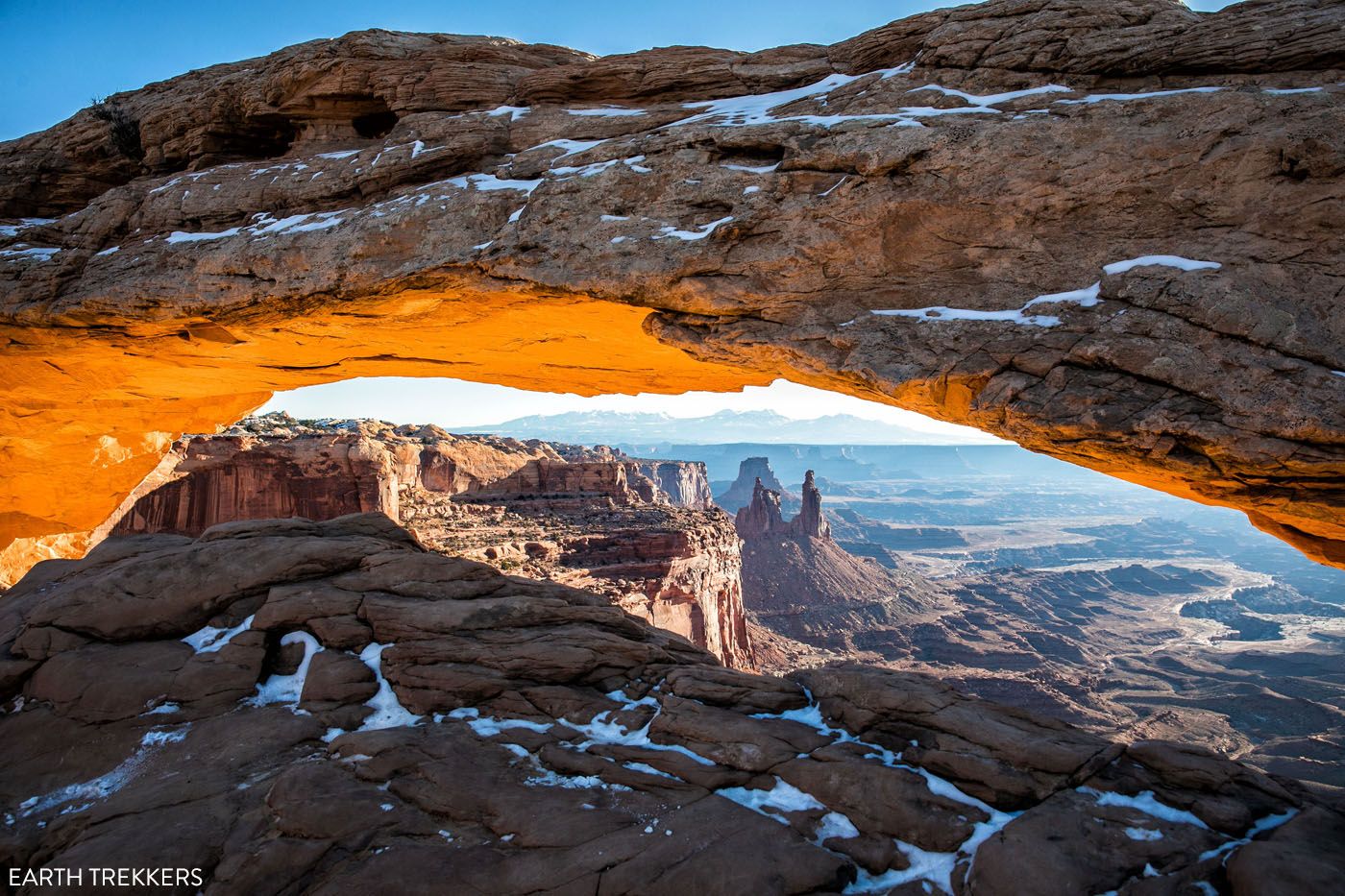
Mesa Arch
From Mesa Arch, drive down Grand View Point Road and enjoy the jaw-dropping views from Grand View Point. From here, you look out over canyons carved out by the Colorado River and way off in the distance is the Needles District. There is a short hiking trail here along the rim which is nice to do if you want to stick around longer to enjoy the view.

Grand View Point
Drive back up Grand View Point Road and consider hiking to White Rim Overlook, a short but sweet trail to another spectacular viewpoint. Take in the view from Buck Canyon Overlook, Green River Overlook, and then drive to Upheaval Dome.
Upheaval Dome is a large crater that was most likely formed by a meteorite, although there are other theories about its creation. To get the viewpoints you will have to do some hiking. It’s an easy to moderate hike on well-marked trails. There are two overlooks and the second one was our favorite. The entire hike is 1.8 miles round trip and it takes 1 to 1.5 hours to hike the whole thing.
Before exiting the park, you have the option to hike Whale Rock (a 1-mile hike to the top of a dome for panoramic views of the park) or Aztec Butte (a 2-mile round trip hike where you get to see ancient granaries).
Before leaving Canyonlands, visit the Shafer Canyon Viewpoint and the Visitor Center Viewpoint for awesome views of the White Rim Road as it switchbacks down Shafer Canyon. If you plan to drive the White Rim Road, this is part of the road you will drive. It’s an incredible experience.
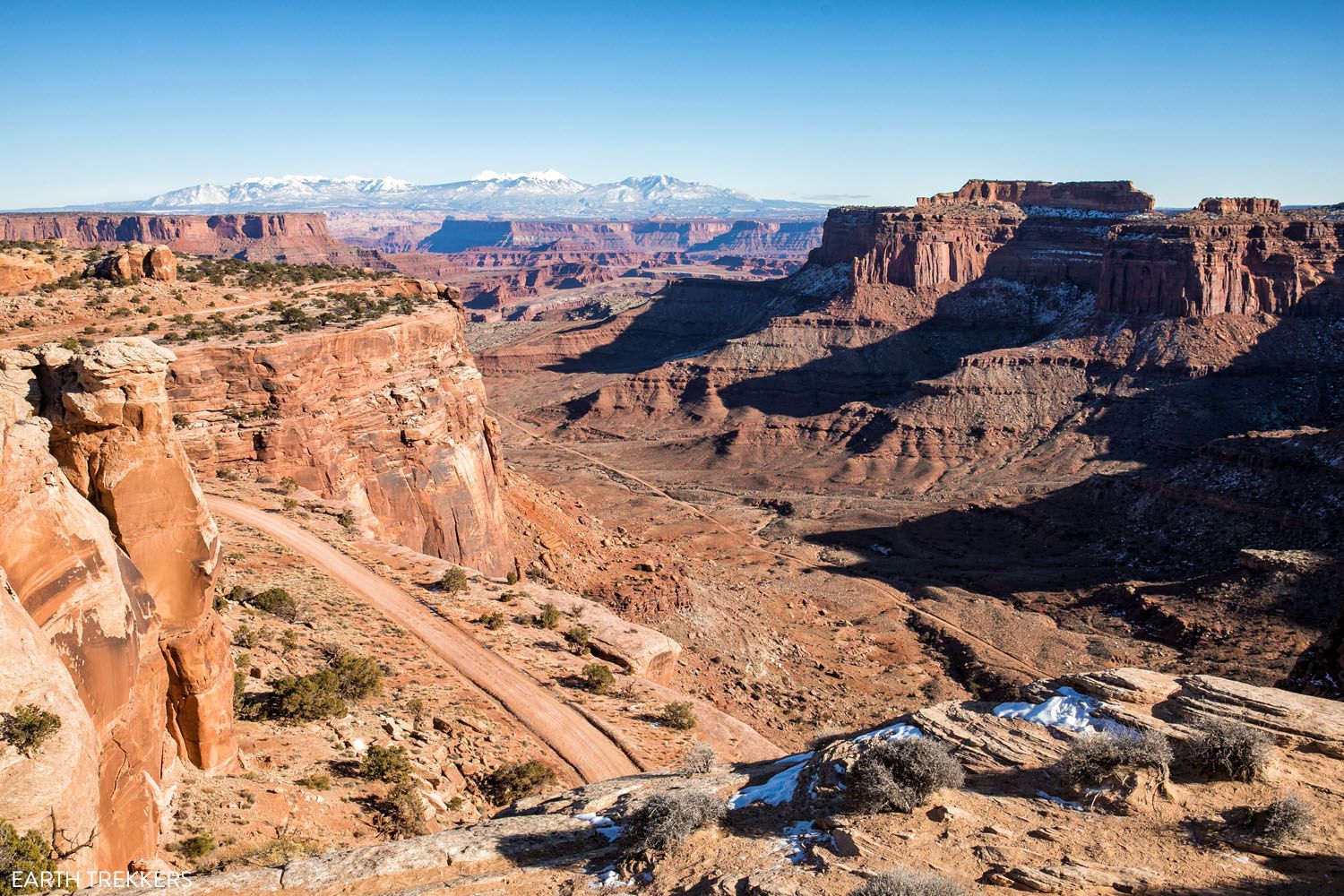
Visitor Center viewpoint and views of Shafer Canyon Road
If you are doing very good on time, you can visit Dead Horse Point State Park before driving back to Moab. You can simply drive through the park to the end of the road for an amazing view of the Colorado River and Canyonlands National Park and/or you can hike one of the short trails here.

Dead Horse Point State Park
For full details about how to spend one day in the Island in the Sky District of Canyonlands and add on Dead Horse Point State Park, read our post One Perfect Day in Canyonlands National Park.
Tonight, sleep in Moab.
Day 4: Canyonlands Needles District
On the Road: 170 miles, 3.5 hours
The Needles District of Canyonlands gets a lot fewer visitors than the Island in the Sky District. But having been here, it is absolutely worth the longer drive to get there. With the colorful sandstone needles, this place looks a lot different than anything else you will see on this itinerary.
The Needles is smaller than the Island in the Sky District. It takes just 10 minutes to drive the main paved road through the park. Along this drive, there are several short hikes to do. Pothole Point Trail is a short, easy hike that’s great for young kids. The Slickrock Trail is longer but the views are a lot better.
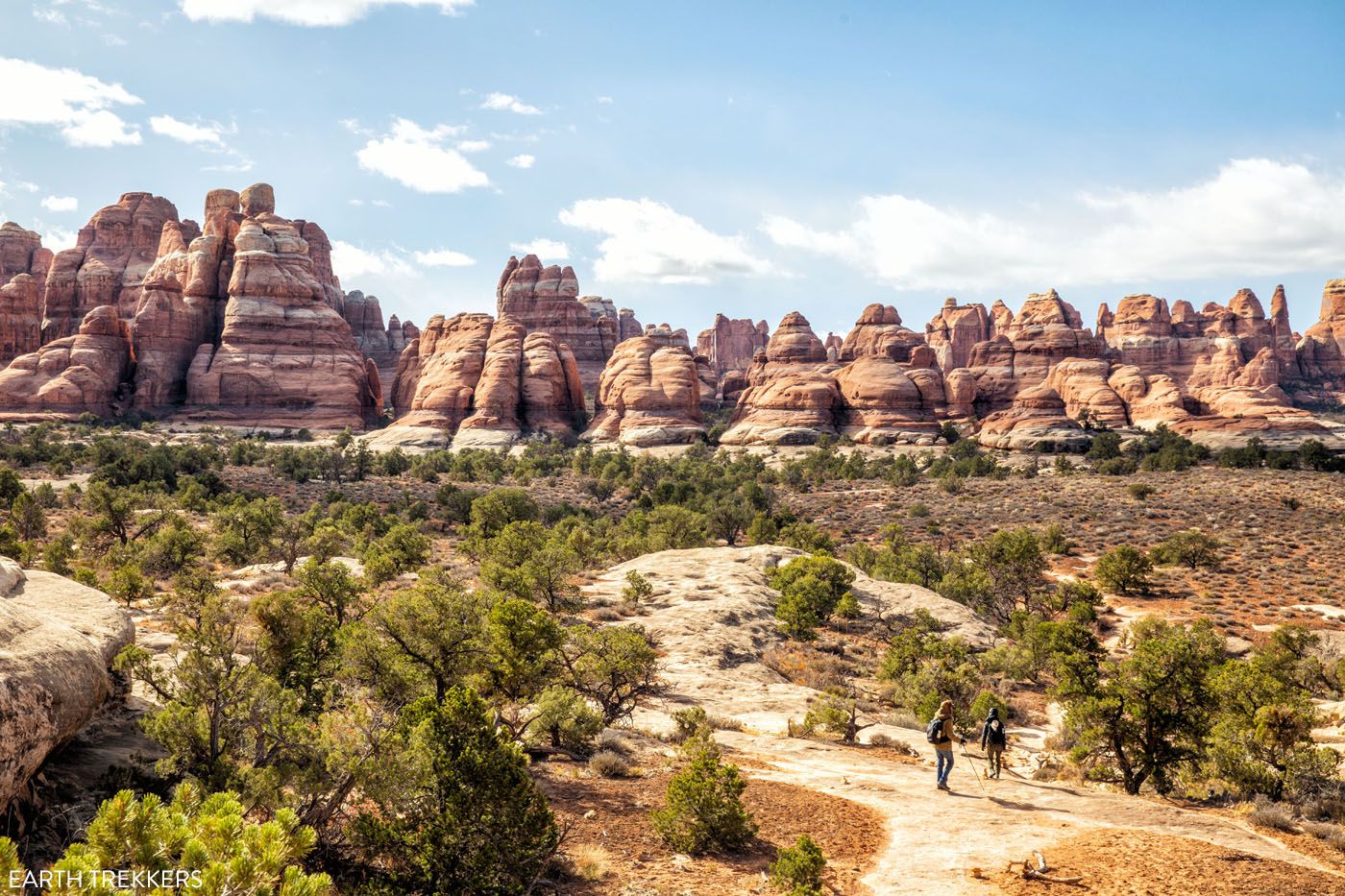
But if you do one hike in the park, I recommend hiking to Chesler Park. This is where you get up close with the Needles, the rock formations that make this part of Canyonlands so uniquely beautiful.
If you hike to the Chesler Park Viewpoint, this hike is 6 miles round trip and takes two to three hours. You can turn this hike into an awesome loop by hiking the Joint Trail and through Chesler Park.
The hike to Druid Arch is another great hike to consider if you are an avid hiker.
LEARN MORE ABOUT THE NEEDLES: 12 Amazing Things to Do in The Needles
Tonight, sleep in Moab.

Day 5: Hiking in Canyonlands, Drive Shafer Canyon Road or the White Rim Road, or Spend More Time in Arches or Moab
Today you have the option to spend more time in Arches or Canyonlands National Park, visit Dead Horse Point State Park if you have not done that yet, or spend some time in Moab.
Hikes in and around Moab
If you are a hiker, consider hiking the Gooseberry Trail or the Syncline Loop in Canyonlands. In Arches, you can drive out and hike Tower Arch or take a ranger-guided tour of the Fiery Furnace.
In Moab, the hike to Corona Arch is a favorite for a lot of visitors. You can also go white water rafting, rock climbing, or take a 4×4 tour along the Colorado River.
White Rim Road
With one day, you can drive part of the White Rim Road. The White Rim Road is an epic experience, where you drive around the Island in the Sky mesa, with jaw-dropping views of canyons, the Colorado and Green Rivers, buttes and mesas, and the La Sal mountains. This is a 100 mile loop that takes most people two to three days. In one day, you can drive a portion of the loop. To do this, you must have a high clearance 4WD vehicle and a permit. Get the full details in guide on how to Drive the White Rim Road in one day.
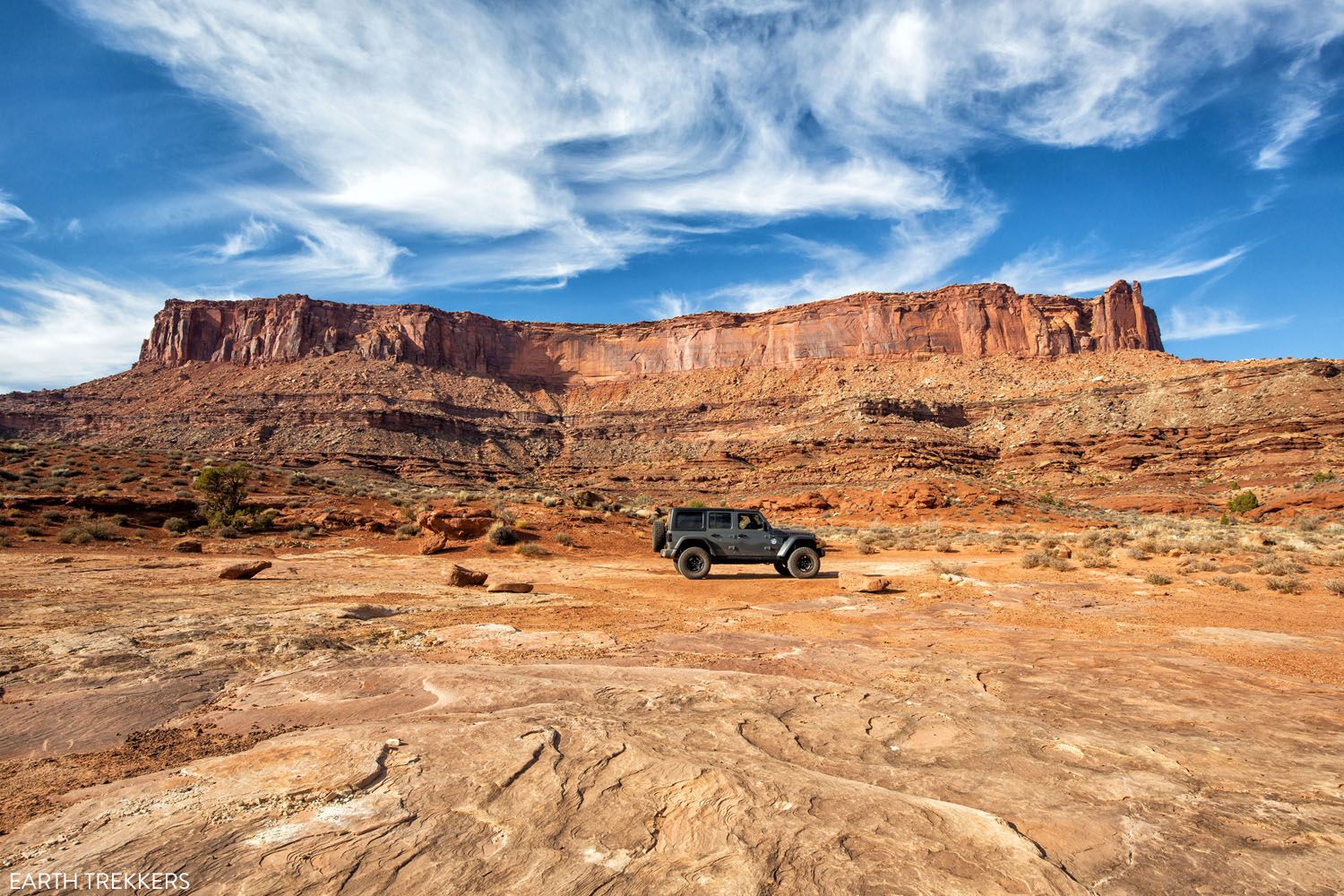
Dead Horse Point State Park + Potash Road
Another idea on how to use this day is to combine Dead Horse Point State Park with a backcountry scenic drive. In the morning, visit Dead Horse Point State Park. In the afternoon, return to Canyonlands Island in the Sky district. Drive down the switchbacks on Shafer Canyon Road and then drive Potash Road back to Moab. Along Potash Road, you drive beneath the overlook at Dead Horse Point State Park and past one of the filming locations for the movie Thelma and Louise. To do this drive, you must have a high-clearance SUV. A 4WD is recommended but not mandatory.
For complete details on how to do this drive, read our article How to Drive Shafer Canyon Road and Potash Road from Canyonlands to Moab.

The switchbacks on Shafer Canyon Road. You can drive these switchbacks to the bottom and then take Potash Road back to Moab. These switchbacks are also part of the White Rim Road loop.

The start of Potash Road

Potash Road as it heads beneath Dead Horse Point
Tonight, sleep in Moab.
Optional: Days 4 & 5: White Rim Road
For the ultimate adventure in Canyonlands National Park, consider driving the White Rim Road.
Over the course of 100 miles, you will circle around the Island in the Sky mesa. Along the way, you will drive along cliff edges, past canyons carved out by the Colorado and Green Rivers, and to viewpoints that will take your breath away.
Once you do this drive, you will never look at Canyonlands National Park the same way again.


It typically takes most people two to three days to drive the White Rim Road. We did it in two days. I think two days is plenty of time, but if you have extra time to spare and like the idea of slowing down and savoring this journey, you can spend two nights and three days along the White Rim Road.
In order to do this drive, you will have to do some advance planning. A permit is necessary to drive the White Rim Road. The number of drivers is limited, which helps cut down on damage to the road but also creates a very quiet, uncrowded experience. When reserving your permit, you will also reserve your campsite.
You also must have a high-clearance 4WD vehicle. This is mandatory and enforced by the national park service.
The permit process and the necessity for a 4×4 may seem like a turn off, but I assure you, it is absolutely worth it for this experience. Driving the White Rim Road blew away our expectations and our expectations were very high. This is one of our favorite national park experiences.
Learn more: How to Drive the White Rim Road and The White Rim Road Planning Guide & Checklist
To add the White Rim Road onto this itinerary, you will start the drive on the morning of day 4 and return to Moab in the afternoon/evening of day 5. The night of day 4 you will camp along the White Rim Road. We did not check out of our hotel in Moab, even though we did not sleep there for one night. It was worth it for us not to bring our luggage and laptops on the drive. It is a very bumpy drive and you and your things will get jostled around quite a bit. However, you could check out of your hotel for one night and have your hotel hold your luggage for you.
Day 6: Little Wild Horse Canyon & Goblin Valley
On the Road: 190 miles, 4 hours
Today, you will drive to Capitol Reef National Park, visiting Goblin Valley and Little Wild Horse Canyon along the way. From Moab, it takes 2 hours to get to Goblin Valley and Little Wild Horse Canyon.
Goblin Valley is another gem of a state park in Utah. It’s small and super easy to explore. You can either hike one of the designated trails or simply wander through the hoodoos. Kids will love this!! A visit here lasts anywhere from one hour to half of a day, depending on how much fun you are having.

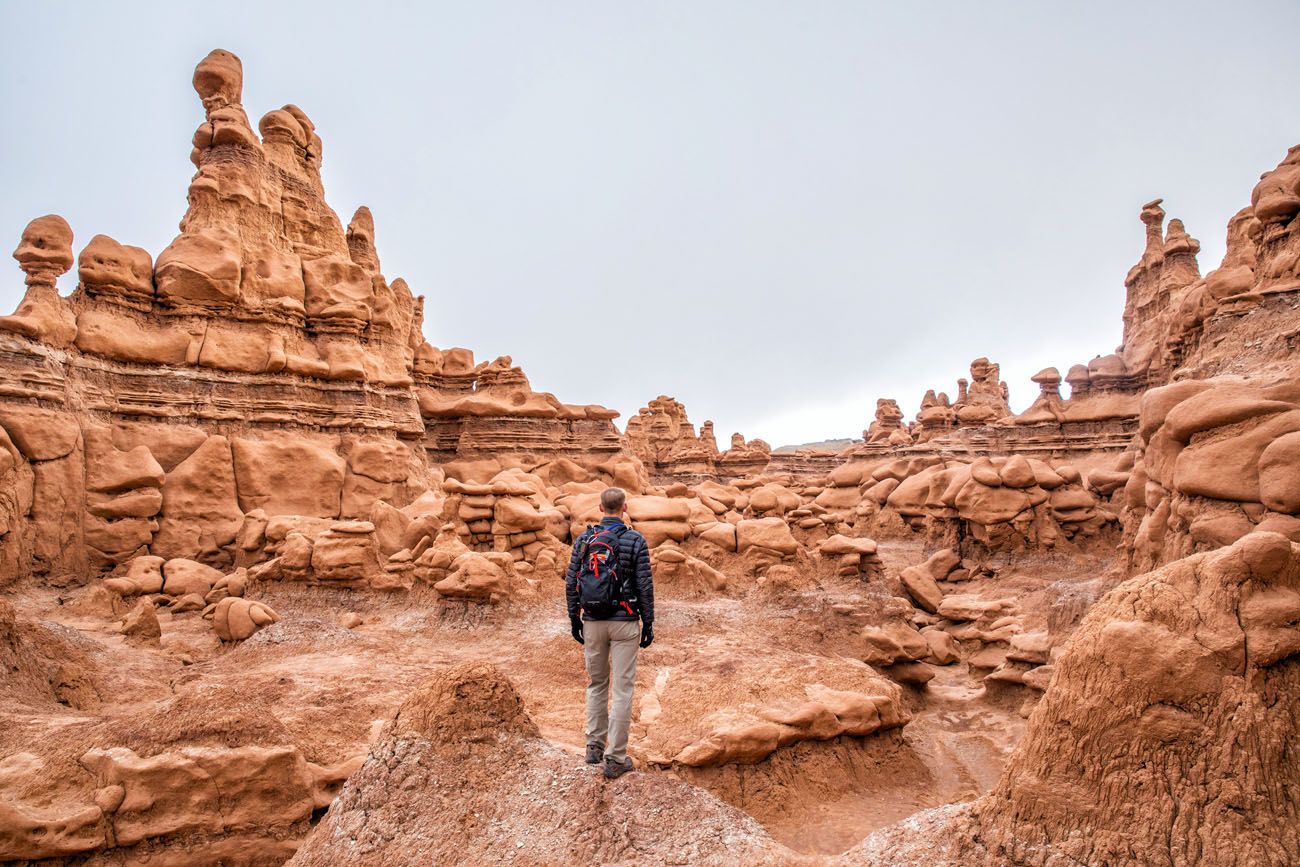
Little Wild Horse Canyon is one of the most thrilling slot canyons in Utah. With tight passageways, curving, scalloped walls, and short sections of easy rock scrambling, this hike is fun for both kids and adults. You can hike the narrowest (and most fun) section of Little Wild Horse as a quick out-and-back hike (about 4.5 miles, 2 to 4 hours), or do this as a loop, adding on Bell Canyon (8.1 miles, 4 to 6 hours).


Goblin Valley and Little Wild Horse Canyon are just 10 minutes apart. You can visit them in either order. We started at Goblin Valley and then hiked Little Wild Horse Canyon.
From Goblin Valley State Park, drive to Capitol Reef National Park. This drive takes just under two hours.
Tonight, sleep in Torrey. You will spend four nights in Torrey.
Where to Stay in Torrey
Skyview Hotel. On our next visit to Capitol Reef National Park, this is where we would stay. This 3-star hotel offers standard hotel rooms with amazing views as well as different style tents. Check out the premium tent with skylight…this is one of most unique and highly rated properties in Torrey.
Capitol Reef Resort. Located in Torrey, very close to the west entrance of Capitol Reef, this property offers a wide variety of beautifully decorated rooms. You can even sleep in a teepee or a Conestoga Wagon. We spent five nights here and had a nice experience. The rooms were clean and quiet. The convenient onsite restaurant, The Pioneer Kitchen, serves decent food and staff are very friendly. However, we have heard reports from other travelers that this property is in need of some renovation, so check reviews before making your decision on where to stay.
SkyRidge Inn. Located in Torrey, this beautiful property offers standard hotel rooms as well as deluxe suites and even a 3 bedroom villa that is perfect for families or small groups.
Cougar Ridge Lodge. This property gets exceptional reviews. Stay in a two-bedroom villa that can accommodate up to seven people, perfect if you are traveling as a family. Each villa has its own patio with stunning views of the surrounding mountains.
Day 7: Capitol Reef National Park
On the Road: 40 miles, 1.5 hours
With three days, it may look like I put a lot of time into Capitol Reef, and I did, but it is worth it. This park is filled with scenic drives and a long list of hiking trails. I think this park is highly underrated.
On your first day, I recommend visiting the highlights of Capitol Reef. From historic Fruita, drive Capitol Reef Scenic Drive to Grand Wash. Hike Cassidy Arch and walk through the first section of Grand Wash. Grand Wash is very similar to the Narrows in Zion, only without the river, so your feet stay dry but you still get to hike through a wide slot canyon.

Capitol Reef Scenic Drive

Cassidy Arch

Grand Wash
Continue down Capitol Reef Scenic Drive and then drive the very cool Capitol Gorge Road to the end. Walk through Capitol Gorge to the Pioneer Register, where settlers in the late 18th century and early 19th century scrawled their names on the canyon walls.
Drive back to Fruita and consider hiking Cohab Canyon Trail or to Hickman Bridge if you still have the energy. See the petroglyphs and end your day with the view from Sunset Point.

View over Fruita from the Cohab Canyon Trail
For full details on how to spend your time today, read our article One Perfect Day in Capitol Reef National Park and follow driving route #3, where you start and end in Torrey.
Tonight, sleep in Torrey.
Day 8: Cathedral Valley
On the Road: 73 miles to drive the loop plus 52 miles to and from Torrey
If you add on one backcountry experience in Capitol Reef, this is the one that I recommend.
Cathedral Valley is a rugged, remote district of Capitol Reef National Park. Few people travel out this way to see this valley and its sandstone monoliths, colorful Bentonite hills, and vast desert scenery. But that’s part of its appeal.
The Cathedral Valley Loop is a 58-mile scenic drive that is located north of the historic Fruita district. Once you add on detours along the drive, the loop clocks in at 73 miles. To do this drive it takes one full day.

Temples of the Sun and Moon

Cathedral Valley

Cathedral Valley
There are no paved roads on this loop, so you must have a high clearance vehicle, and having a 4×4 is strongly recommended. If you don’t have the proper vehicle then consider doing one or two hikes in Capitol Reef National Park.
Along the drive, you will get to see the iconic Temples of the Sun and Moon, take in the views from several stunning overlooks, and have the option to hike a short trail or two.
For full details on what to expect and how to plan your drive, take a look at our post Guide to the Cathedral Valley Loop.
Tonight, sleep in Torrey.
Day 9: Capitol Reef National Park
Today, you have several options. You can either go on another backcountry driving experience or spend time hiking in Capitol Reef National Park.
Option #1: Loop the Fold
On the Road: 125 miles
This remote drive loops around the waterpocket fold in the southern part of the park. Like Cathedral Valley, Looping the Fold takes roughly one full day.
On this loop, you will drive down Notom-Bullfrog Road. It starts off as a paved road but eventually turns to gravel. While it may be suitable for standard cars, we highly recommend having a high-clearance vehicle. Along Notom-Bullfrog Road, you have the option to hike many slot canyons. Headquarters Canyon and Surprise Canyon are two very easy slots to add onto this drive.



The loop continues on Burr Trail Road. You’ll climb up the legendary Burr Trail switchbacks, and the higher you go, the better the views. Hike out to Strike Valley Overlook, where you get panoramic views of Strike Valley and Notom-Bullfrog Road.
Just beyond the overlook, the road becomes paved and you enter Grand Staircase-Escalante National Monument. The drive twists and turns through Long Canyon before arriving in Boulder. Take Utah Highway 12 north to return to Torrey and Capitol Reef National Park. Along the way, you will drive up and over Boulder Mountain, which offers more incredible views along the way.
This is another incredible experience to have in Capitol Reef National Park. Since it is so remote, crowd levels are extremely low. We had the slot canyons all to ourselves and saw just a few cars on the entire drive. If you like the idea of going off-the-beaten-path, I highly recommend Looping the Fold.
LEARN MORE: How to Loop the Fold in Capitol Reef National Park
Option #2: Take Your Pick from These Hikes
On the Road: Minimal
Cohab Canyon: 3.4 miles, strenuous. This short but strenuous hike offers stunning views over Fruita and along Highway 24. This hike is one of the easiest ways to get an aerial view over Fruita.
Rim Overlook and Navajo Knobs: It is a 4.6 mile round-trip hike to the Rim Overlook. From a viewpoint high above Fruita, you get an amazing view along the waterpocket fold. Add on the Navajo Knobs for a total round-trip distance of 9.5 miles. This is a tough hike but it’s our favorite in the park. From here, you get 360° views of Capitol Reef National Park. Learn more here.
Chimney Rock: 3.6 miles, moderate. After a short and strenuous climb, this trail stays relatively flat, as it makes a loop along the sandstone mountains. The views of Fruita and the waterpocket fold are spectacular.
Burro Wash, Cottonwood Wash and Sheets Gulch. Each of these three slot canyons are located relatively close to one another on Notom-Bullfrog Road. They range from 7 to 14 miles round-trip and are moderate to strenuous. There could be pools of water in the canyons. If you are looking for a challenging slot canyon, these are hikes to consider.
LEARN MORE: 16 Epic Day Hikes in Capitol Reef National Park
Tonight, sleep in Torrey.
Day 10: Return to Salt Lake City, Fly Home
On the Road: 220 miles, 3.5 hours
In the morning, drive to Salt Lake City International Airport. In the afternoon, fly home. The drive takes 3.5 hours and you need time at the airport before your flight. If you can’t get an afternoon flight or don’t want to risk road delays, then head to Salt Lake City in the afternoon of day 9 and sleep near the airport.

Arches Canyonlands and Capitol Reef Itinerary: Interactive Map
How to Use This Map: Click the tab in the top left corner of the map to see a list of the points of interest and to turn layers on/off. Click the icons on the map to get more information about each point of interest.
To take this map with you, click the star next to the title of the map which adds it to your Google account. Next, within your Google Maps app, select ‘Saved’ and then select ‘Maps’. This map title will now appear in your list.
How to Modify This Itinerary
With Less Time
If you want to visit Arches, Canyonlands, and Capitol Reef National Parks but don’t have a full 10 days, what should you eliminate?
To make this a 9-day itinerary, remove one day from Capitol Reef National Park. This gives you two full days in the park. Visit the highlights on day 1 and on day 2, visit Cathedral Valley or go hiking.
To make this an 8-day itinerary, eliminate one day in Capitol Reef and the bonus day in Moab (day 5 of the 10-day itinerary). This still gives you one full day to explore Arches and two days to explore Canyonlands National Parks.
To make this a 7-day itinerary, use my suggestions for the 8-day itinerary and either eliminate the Needles or another day from Capitol Reef.
Sample 7 Day Itinerary
Day 1: Arrive in Moab
Day 2: Arches National Park
Day 3: Canyonlands, Island in the Sky
Day 4: Goblin Valley & Little Wild Horse Canyon
Day 5: Capitol Reef National Park
Day 6: Capitol Reef National Park
Day 7: Fly Home
With More Time
If you have more than 10 days for this Arches, Canyonlands, and Capitol Reef National Parks itinerary, I recommend putting more time into the parks.
Two full days in Arches gives you plenty of time to visit the highlights and the off-the-beaten-path sights.
You can easily spend five days in Canyonlands: one day for the Island in the Sky highlights, one day for hiking in the Island in the Sky, one day in the Needles, and two days to drive the White Rim Road. With even more time, and a 4WD, you could spend several days exploring the Maze district of Canyonlands National Park.
Tim and I recently spent four days in Capitol Reef. Here is how we spent our time:
Day 1: Highlights along Capitol Reef Scenic Drive, Cassidy Arch, and Cohab Canyon Trail
Day 2: Cathedral Valley
Day 3: Navajo Knobs Trail
Day 4: Loop the Fold
I wish that we had one more full day in the park to get to one or two more hikes, for a total of five days in Capitol Reef.

Capitol Reef National Park
Arches, Canyonlands and Capitol Reef Itinerary without a 4WD
If you don’t want the expense of renting a 4WD or have no desire to venture into the backcountry, here is an itinerary that does not require a 4WD or a high-clearance vehicle.
Day 1: Arrive in Moab
Day 2: Arches National Park
Day 3: Canyonlands, Island in the Sky
Day 4: Canyonlands, The Needles
Day 5: More Time in Arches, Canyonlands, or Moab
Day 6: Goblin Valley and Little Wild Horse Canyon
Day 7: Capitol Reef Highlights
Day 8: Hiking in Capitol Reef
Day 9: Loop the Fold (but check with rangers at the Capitol Reef Visitor Center about road conditions before you go)
Day 10: Fly home

The Needles District of Canyonlands National Park
Best Time for this Road Trip
You can visit Arches, Canyonlands, and Capitol Reef all year.
The best time to do this road trip is in the spring (March through May) and the fall (mid-September through November), when temperatures are mild.
During the summer months, temperatures soar in Utah, and it is not unusual for temperatures to go above 100°F. If you plan to do this road trip in the summer, be prepared for intense midday heat. Try to do most of your hiking and sightseeing in the morning and evening, taking a break midday.
In the winter, it can be quite cold. In January, the average high lingers around 42°F with freezing temperatures at night. Snow is a possibility from November through February, but for the most part, the weather is dry and skies are clear. Snow can temporarily close the roads in the park, in particular the unpaved backcountry roads.
Our favorite time to visit Utah is in October, with great weather and lower crowds than you typically see in the summer months. If you want decent weather and low crowds, November and March are good times to visit Arches, Canyonlands, and Capitol Reef.
We did this road trip in early November and we had a little bit of everything. Daytime highs ranged from 70°F to 35°F. Most days we had crystal clear skies but when a cold front moved through, we had rain, hail, and snow.
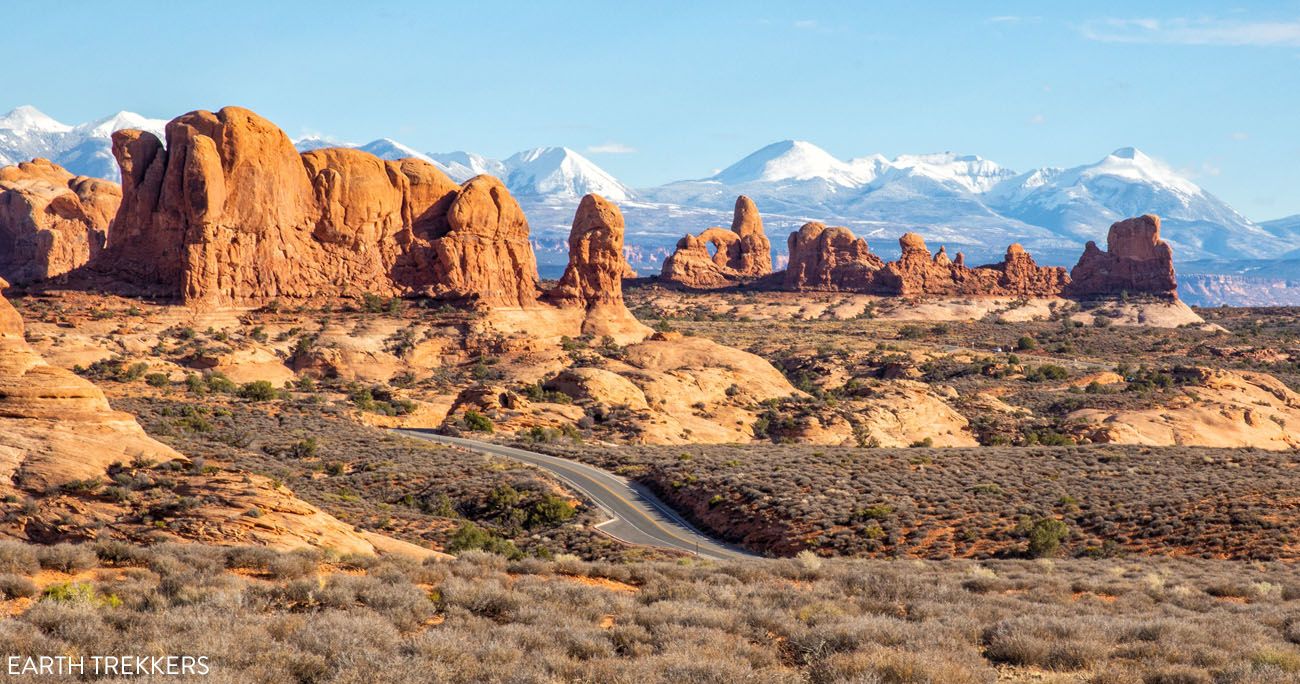
Arches National Park
Planning Your Trip
Hotels
For the 10-day Arches, Canyonlands, and Capitol Reef National Parks itinerary, you will stay in Moab for 5 nights and Torrey for 4 nights. Links to recommended hotels are listed earlier in this post.
State Park Fees
- Dead Horse Point State Park: $20 per vehicle (up to 8 people) for 2 consecutive days
- Goblin Valley State Park: $20 per vehicle, valid for 2 days
National Park Fees
Here are the fees to enter each park. When you pay the entrance fee, it is valid for 7 days.
- Arches NP: $30
- Canyonlands NP: $30
- Capitol Reef NP: $20
Grand Total: $80
America the Beautiful Pass
If you have plans to visit Arches, Canyonlands, and Capitol Reef National Parks, you break even if you purchase the America the Beautiful Pass. This annual park pass costs $80 and is valid for one year. It is worth purchasing the America the Beautiful Pass if you plan to visit more national parks or federal recreational sites within the year.
Purchase your pass at the first national park that you visit (in this case, at Arches National Park) or you can get it online.
Click here to learn more.
Important Links for Arches, Canyonlands, and Capitol Reef
Here are the links to each national park website. Check park conditions and road closures before you go.
Get a Digital Download of this Itinerary
Do you want a printer friendly version of this itinerary? How about an eBook version of this itinerary that can be downloaded onto your computer or mobile device?
Our Arches Canyonlands and Capitol Reef National Parks Itinerary eBook includes this full 10-day itinerary, with detailed daily schedules, insider tips, and travel planning resources. It is a 22-page itinerary that you can download to take with you or print at home.
Click here to purchase the eBook on Etsy.com.

If you have any questions about this road trip through Arches, Canyonlands, and Capitol Reef National Parks, let us know in the comment section below.
Read all of our articles about the USA in our United States Travel Guide.








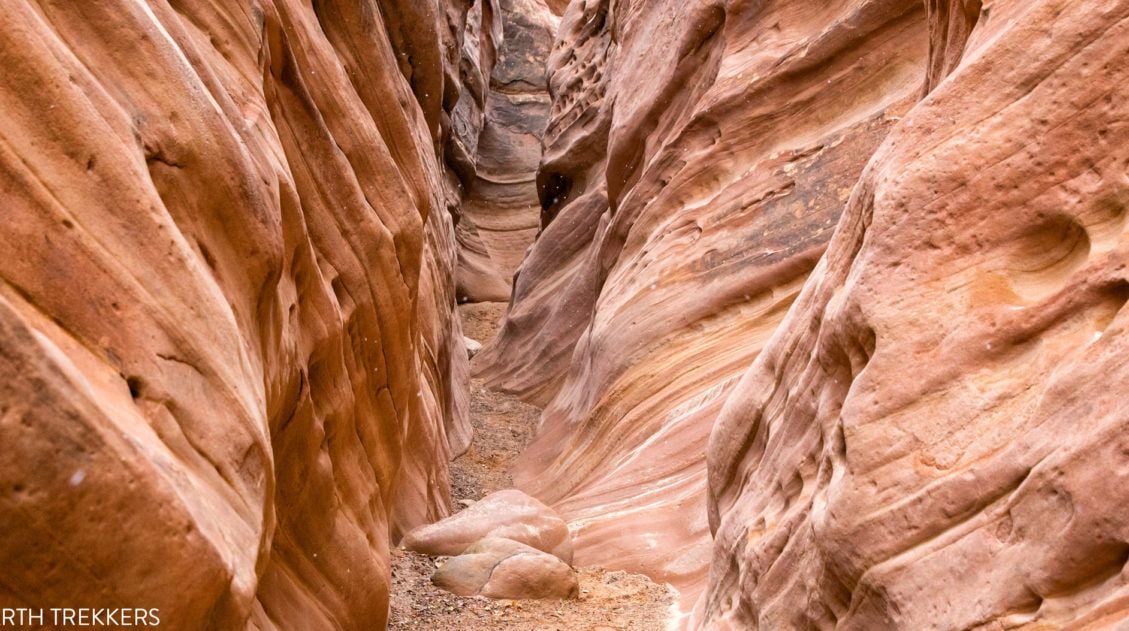

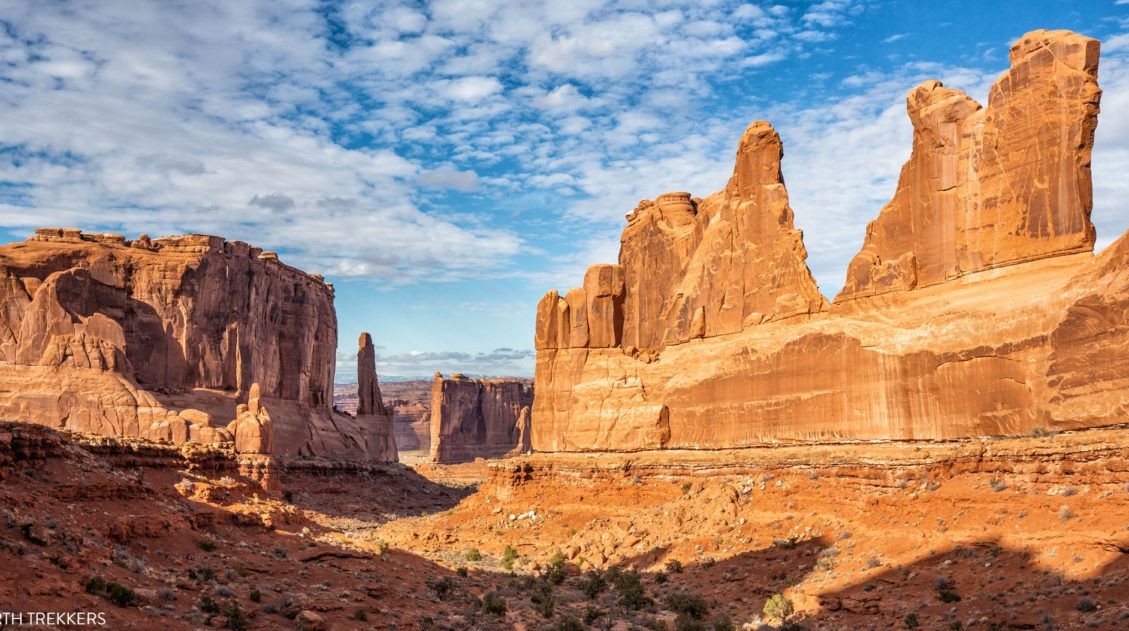



Comments 41